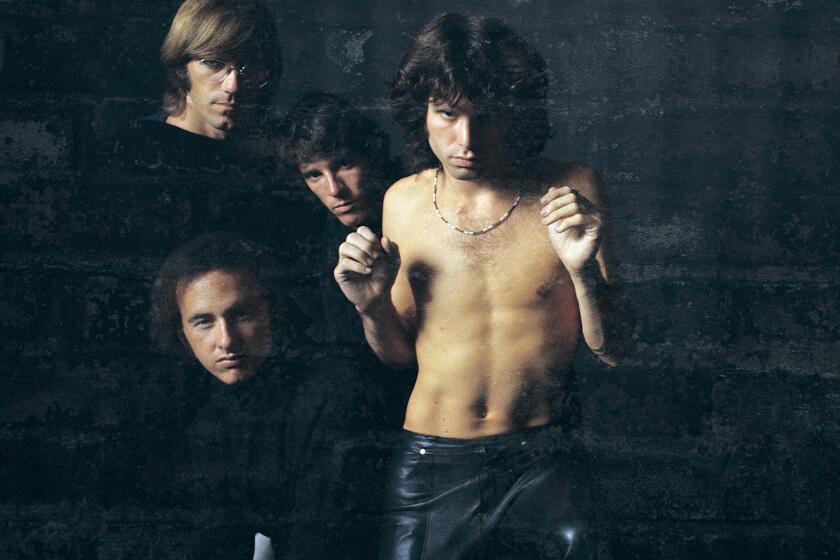Early Evidence of Fitzgerald’s Prowess
- Share via
Ella Fitzgerald was 18 when she first recorded with the Chick Webb Orchestra in 1935. Three years later, her “A-Tisket, A-Tasket” was a national hit. A year after that, the 22-year-old singer became the nominal leader of the orchestra when drummer Webb, who was born with a deformity described as tuberculosis of the spine, succumbed to failing health.
Although the Webb ensemble, with Fitzgerald at the helm, was actually under the musical direction of saxophonist and arranger Teddie McRae, she was its starring attraction. Even before Webb passed away, half the numbers in the orchestra’s book featured Fitzgerald vocals, and the presence of her singing increased dramatically over the next couple of years.
In the ‘50s, Fitzgerald--urged on by producer Norman Granz--was one of the first major artists to release extensive recordings of live performances. Her success in such settings was undoubtedly due to her remarkable musical skills, her capacity to sing with unerring pitch, sumptuous sound and a driving sense of swing, no matter what the circumstances. Adapting to performing with Duke Ellington as easily as she did with Louis Armstrong, she appeared on live concert recordings with both, as well as, among others, Joe Pass, Roy Eldridge, Oscar Peterson and the Count Basie Orchestra.
A newly released collection of Fitzgerald songs, “Ella Fitzgerald: In the Groove” (****, Buddah Records)--recorded live with her orchestra in 1939 and 1940 via radio air checks from New York’s Savoy and Roseland Ballrooms and Chicago’s Grand Terrace--offers utterly fascinating evidence that her comfort in a live setting was present virtually from the beginning. Some of the talents that would grow and expand in future decades are present primarily in embryonic form, but all are immediately identifiable as the essential elements of the Fitzgerald style.
Her scat singing, for example, usually associated with the bebop phrases in her seminal renderings of “Lady Be Good” and “How High the Moon,” emerge here--”Oh Boy I’m in the Groove” and “St. Louis Blues” are good examples--in hard-driving swing-era phrasing, the rhythm and style clearly linking her to the inventor of vocal scatting, Louis Armstrong.
Fitzgerald’s balladry, so stunning in her series of “Songbook” albums from the ‘50s and ‘60s, was extraordinary in 1939, as well. Four of the 21 tracks included in the CD feature her versions of newly minted songs that would eventually become standards: “Day In, Day Out,” “My Prayer,” “Stairway to the Stars” and “The Lamp Is Low.” She sings each, within the stylistic constraints of the big-band instrumentation, with an obvious capacity to grasp the fine points of new material.
Like every other artist who ever had a hit, Fitzgerald was under pressure to follow up “A-Tisket, A-Tasket” with another catchy novelty tune, and a pair of far less successful attempts are present in the collection: “My Wubba Dolly” and “Betcha Nickel.” Both are performed in similar fashion, with the orchestra singing brief, unison call-and-response patterns with Fitzgerald. Like “A-Tisket, A-Tasket,” the tracks showcase her gift for making something out of the most minimal material. And a pair of other novelty tunes make even greater demands on her musical good nature. On “Yodelin’ Jive” she actually manages to come up with some jazzy yodeling. And, on “Sing Song Swing,” a song about “Cholly Ching” that would have been a major item in the long list of politically incorrect prewar tunes, she enhances the distressing lyrics with a few lines of sprightly scatting.
The high point of the album, however, is a five-minute-plus rendering of “St. Louis Blues” in which Fitzgerald’s gift for melodic improvisation is immediately apparent when she virtually abandons the familiar theme in favor of her own delicious variation. The piece proceeds with a jam session feeling, with Fitzgerald urging on various soloists and tossing her own scat phrases back and forth. The performance demonstrates the extent to which the orchestra and Fitzgerald were integral elements, each reacting to and interacting with the other. By allowing her to grow and mature freely as an artist, the orchestra’s outings were powerfully enhanced by the musical creativity and excitement that resulted.
Unfortunately, the CD’s packaging doesn’t match the quality of the music. Aside from occasional references within a thoughtful essay by Will Friedwald, there is no documentation of the soloists on the various tracks (although it’s apparent that some of the fine offerings were delivered by tenor saxophonist McRae, trumpeter Taft Jordan and pianist Tommy Fulford). And, despite the assumption that McRae had a hand in the arrangements, there are no specific credits for any of them. But Fitzgerald’s music makes it all worthwhile.
Carmen McRae (no relation to Teddy McRae) was only three years younger than Fitzgerald, but she did not move into the wider jazz spotlight until she was well into her 30s. “Carmen McRae” (***, Bethlehem Archives) compiles material--eight tunes and five alternate takes--from two 1954 sessions recorded with the Mat Mathews Quartet and the Tony Scott Quartet. Only two of the songs--”You’d Be So Easy to Love” and “Old Devil Moon”--are standards. The balance includes a McRae original, “Last Time for Love,” an odd, darkly mournful pairing with Scott (on piano rather than clarinet) in his appropriately titled tune “Misery,” and a group of obscure songs associated with Mathews, recorded by McRae as, in effect, demos.
Despite the less than challenging program, much of the McRae magic is present. Still reflecting qualities of Fitzgerald, Billie Holiday and Sarah Vaughan, she was not quite yet at the stage in which she would offer her own alternative. But the clarity of her line, the articulation of her lyrics, the honey-smooth sound are all present, ready to emerge and combine into the expression of a mature jazz vocal master.
More to Read
The biggest entertainment stories
Get our big stories about Hollywood, film, television, music, arts, culture and more right in your inbox as soon as they publish.
You may occasionally receive promotional content from the Los Angeles Times.










